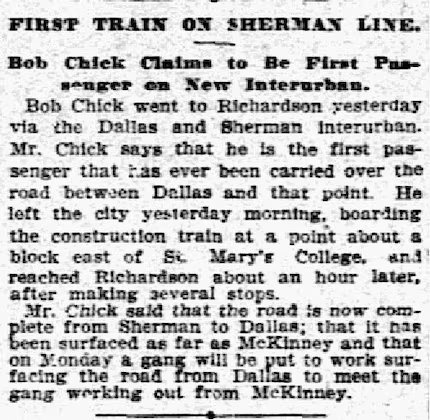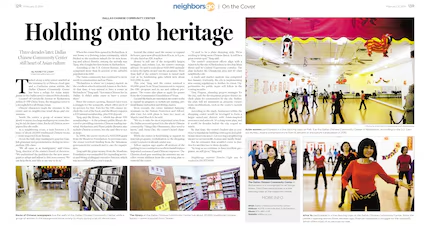Editor’s note: Take a look back in The Dallas Morning News Archives and the Richardson, Texas collection.
With a rich history dating to the 1840s, Richardson has seen a steady growth from a small farming settlement to a prospering part of North Texas’ Silicon Prairie. Besides the city’s economy, residents enjoy the convenience of location and culture, a top-notch public university, a rapidly expanding community college, and vibrant arts and recreation programs.
Comanche and Caddo native tribes inhabit the lands
According to the city of Richardson website, “in the 1840s, settlers from Tennessee and Kentucky began arriving in the Richardson area, which was inhabited by Comanche and Caddo Indian tribes." The settlers created a community called Breckinridge in the area around present-day Richland College.

The Houston and Texas Central Railway was enticed with a land donation from William J. Wheeler and Bernard Reilly on June 23, 1873. They chose the land over the small settlement of Breckinridge, just a few miles away.
The men declined to have the new settlement named after them. Instead, the city of Richardson got its name from either of these two important men, A.S. Richardson or E. H. Richardson. The city claimed it was named for A.S. Richardson, secretary of the Houston and Texas Central Railway.
Richardson gets a stop on the electric railway

In 1908, Richardson became a stop on the Interurban, an electric railway, between the cities of Dallas, Sherman and Fort Worth. Bob Chick was reported on April 17 to have been the first passenger to ride the electric railway, which took an hour to reach Richardson.
The town had a very busy year in 1925, when it was incorporated and had its first election to fill the newly created positions of mayor, city commissioner, chief of police and city clerk. Residents also voted to create a waterworks plan on Aug. 23, 1925.
Richardson Fair shuts down Main Street
World War I and the Great Depression did not slow Richardson’s progress in becoming a commercial and residential destination. The small farming town created a popular agricultural fair on Main Street in the early ’20s that lasted until the ’70s.

The funds from the Richardson Fair helped support the Richardson Fire Department, which started out as a volunteer fire department in 1926. On Aug. 24, 1941, The News reported that “if the fair harvest is fat and other things go right, the Richardson fire department will get a new fire station.” It is unknown if they got enough money for the new station.
Richardson becomes part of Silicon Prairie and attracts big business

In the ’50s, Collins Radio, the electronics company in Cedar Rapids, Iowa, picked Richardson to build a campus. This was the first of many technology-based companies to come to Richardson. Texas Instruments built a campus adjacent to Richardson in 1956, which led to an increase in interest in commercial and residential land development.
On Oct. 8, 1961, The News published “Richardson Expansion Orderly, Sound, Conforms Strictly with Master Plan.” This master plan was to help Richardson have a smooth transition as more companies like Bauer Aluminum Co., Owens Country Sausage, Cassidy Feed Mills and Sun Oil’s laboratory started building factories and business complexes.
Richardson chosen for University of Texas at Dallas and Richland College

In 1961, Geophysical Services Inc. founders and owners Eugene McDermott, Cecil Howard Green, and J. Erik Jonsson saw a shortage of engineers in the area, so they founded the Graduate Research Center of the Southwest. The school was renamed Southwest Center for Advanced Studies in 1967.
By 1969, House Bill 303 was in the works. The bill would bring the Southwest Center for Advanced Studies into the University of Texas fold and rename it the University of Texas at Dallas as of Sept. 1, 1969.
On April 29, 1972, Richland College in Dallas enrolled its first two students, Kathy Carnathan and David McPeek. Richland was the fourth campus of the seven-campus system for the Dallas County Community College District.
Since early settlements, Richardson aims to strengthen community ties

Each December since 1989, the Richardson Public Library and the city has hosted Santa’s Village. The community band can be seen performing there.
In 1993, Richardson hosted the first Wildflower! Arts and Music Festival. Since then, the festival has gained a huge following that brings in people from all over North Texas.
Richardson — a home to different cultural backgrounds
The city’s website states that about 40% of Richardson’s homes were built during the boom of the 1970s. The 1990 U.S. census showed a city population of 74,840, which increased to 99,223 in 2010 and to an estimated population of 120,981 in 2018.

The Islamic Association of North Texas was founded in 1969 and built a mosque and a school on the corner of Abrams Road and Centennial Boulevard in 1985.
For nearly three decades, the Dallas Chinese Community Center has been in a Richardson shopping center called D-FW China Town. It has been serving the community with a library, celebrations and classes. Other shops in D-FW China Town include Jeng Chi Restaurant, 85 Degree C Bakery and Cafe, and Good Fortune Supermarket.
In current news— the city’s residential and commercial growth

In 2018, it was reported that the Comerica Bank building was in the works for redevelopment, with plans for retail, office and residential space.
On Jan. 18, 2019, The News’ Real Estate Editor, Steve Brown, reported: “Richardson’s $1.5 billion CityLine project is home to more than 12,000 workers for big companies, including State Farm Insurance and Raytheon.”
Reported in The News on May 31, 2019, the city and developers Durkin Properties and Catalyst Urban Development have plans to update the historic downtown Main Street district.
From a small piece of farming land, Richardson has been able to emerge as a rival city in the D-FW technology scene. The city has experienced expansion to touch three major highways and connect to other booming suburbs including Frisco.
Interested in learning more about local history? Become a Dallas Morning News Plus subscriber at archives.dallasnews.com.


